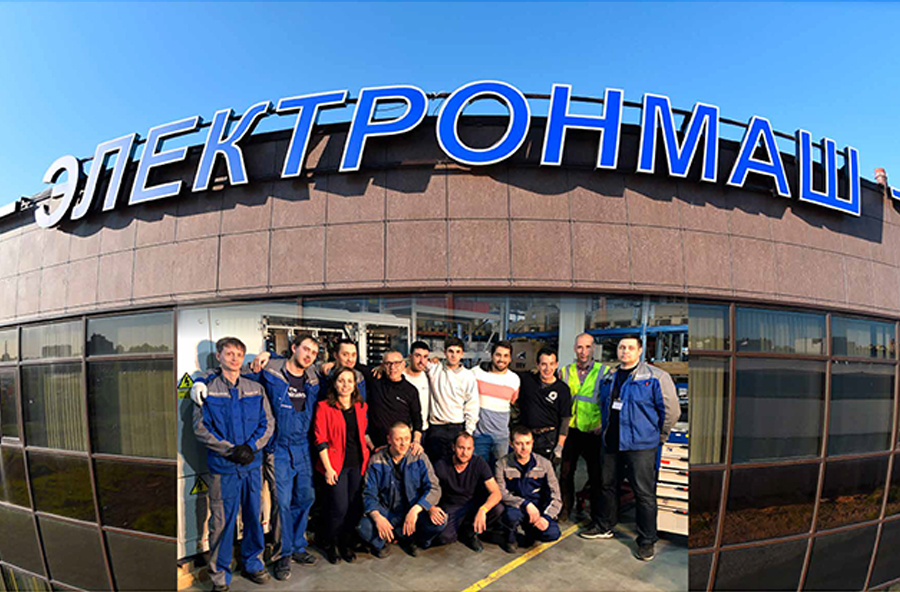Технологическое партнерство - приоритет ветроэнергетики
10 июня 2019
Источник: Energy and Industry of Russia. Issue No. 09 (365) May 2019
Темы:

За сравнительно короткое время ветроиндустрия успела стать одним из главных мировых трендов. И сейчас это направление ВИЭ обсуждают не только как интересное решение, эксперимент или инструмент: эксперты говорят, что это отрасль, способная обеспечить профицит энергии и ускорить развитие экономики целого государства.
Кроме того, ветроэнергетика – высокотехнологичный бизнес с многомиллиардными оборотами. Однако при всей оптимистичности прогнозов на пути развития отрасли остаются непростые вопросы, которые необходимо решать. Об этом и не только мы побеседовали с исполнительным директором АО «Электронмаш» Андреем Литвиненко.
– Ветроэнергетика получает стремительное развитие по всему миру и уже стала мощной самостоятельной отраслью. Но насколько она нужна в России?
– Если рассуждать о необходимости ветроэнергетики в России, то, наверное, следует задать вопрос, о каком интервале времени идет речь. Если говорить о завтрашнем дне, например об июне 2019 года, то автоматически в голове формируется послание – зачем оно нам, у нас и так все хорошо, это что‑то связанное с политически модными мировыми решениями. Мы имеем достаточный запас углеводородов, мы имеем необходимый запас генерирующих мощностей, мы боремся за энергоэффективность, население России, к сожалению, не увеличивается в арифметической прогрессии, а значит, теоретически у нас должно всего хватать.
Но так кажется только в первый момент и только при измерении потребности на коротком интервале, когда мы просматриваем пласт окружающих нас сиюминутных реалий; однако, посмотрев на всю ситуацию с позиции долгосрочной перспективы, становится весьма очевидным, что ветроэнергетика и прочая альтернативная энергетика – это весьма перспективное занятие.
Безусловно, первыми такие перспективы увидели и почувствовали страны с низкими запасами углеводородных ресурсов, да и не только углеводородных, но и территориальных, такие, как Германия, Дания, Испания, Британия и Франция. При этом исторически это страны с высоким промышленным и экономическим потенциалом, позволяющим провести направленные разработки своеобразного «вечного двигателя», формулу которого все ищут еще со Средних веков.
Но на деле у всего, что происходит в технической сфере, всегда находится очень крепкая экономическая основа. И, собственно, независимость ветроэнергетики от стоимости и доступности углеводородов – это и есть основной драйвер роста этой отрасли.
На сегодняшний день мир имеет высокотехнологичное машиностроение, развитые средства моделирования аэродинамики объектов, отличные возможности наблюдения и прогнозирования на основе накопленных данных и статистических моделей климата, и, соответственно, все это позволяет создавать современные высокотехнологичные «вечные двигатели» – ветротурбины до 8 МВт, мощность выработки которых сопоставима с энергопотреблением одного района среднестатистического российского города-миллионника.
Сейчас и у нас, в России, приходит понимание, что ветроэнергетика – это не эксперимент, не гаджет, не дубинка экологов, а отрасль, способная быстро обеспечить энергетический профицит и развитие экономики, с одной стороны, а с другой стороны – это высокотехнологичный бизнес с многомиллиардными оборотами, и сейчас мы в роли покупателей, оказавшихся на технологической обочине.
А понимание всего этого и приводит нас как предприятие электротехнического сектора к тому, что пришел тот час, когда необходимо срочно включаться в борьбу за технологии производства электроэнергии из возобновляемых источников.
Следует отметить, что простота самого принципа преобразования энергии ветра в электрическую энергию вовсе не означает технологическую простоту, а современная ветроустановка мощностью в несколько мегаватт – это совокупность последних технических достижений. Так, нужно обеспечить прочность и легкость гигантских лопастей ветроколеса, гондолы и башни, должен быть применен специализированный генератор, прецизионный механический мультипликатор и, наконец, конвертор на базе силовой электроники. И все это должно работать и взаимодействовать под управлением специального программного обеспечения. Для реализации таких проектов должны применяться последние достижения в аэродинамике, материаловедении, металлообработке, электротехнике, силовой электронике, программировании и строительстве, от этого зависит эффективность всей установки, и борьба идет за десятые доли процента.